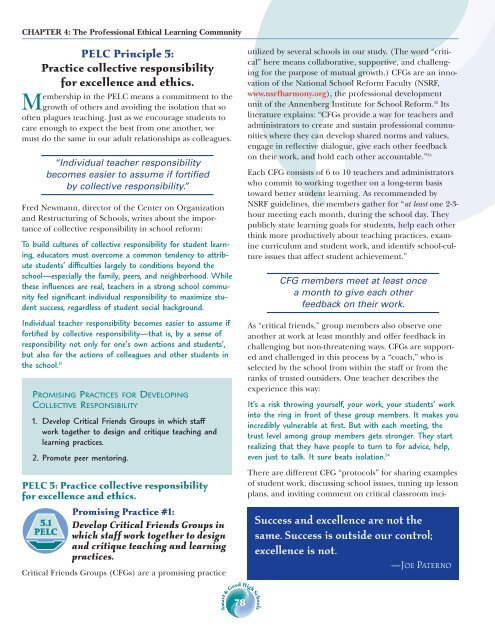Smart & Good High Schools - The Flippen Group
Smart & Good High Schools - The Flippen Group
Smart & Good High Schools - The Flippen Group
- No tags were found...
You also want an ePaper? Increase the reach of your titles
YUMPU automatically turns print PDFs into web optimized ePapers that Google loves.
CHAPTER 4: <strong>The</strong> Professional Ethical Learning CommunityPELC Principle 5:Practice collective responsibilityfor excellence and ethics.Membership in the PELC means a commitment to thegrowth of others and avoiding the isolation that sooften plagues teaching. Just as we encourage students tocare enough to expect the best from one another, wemust do the same in our adult relationships as colleagues.“Individual teacher responsibilitybecomes easier to assume if fortifiedby collective responsibility.”Fred Newmann, director of the Center on Organizationand Restructuring of <strong>Schools</strong>, writes about the importanceof collective responsibility in school reform:To build cultures of collective responsibility for student learning,educators must overcome a common tendency to attributestudents’ difficulties largely to conditions beyond theschool—especially the family, peers, and neighborhood. Whilethese influences are real, teachers in a strong school communityfeel significant individual responsibility to maximize studentsuccess, regardless of student social background.Individual teacher responsibility becomes easier to assume iffortified by collective responsibility—that is, by a sense ofresponsibility not only for one’s own actions and students’,but also for the actions of colleagues and other students inthe school. 31PROMISING PRACTICES FOR DEVELOPINGCOLLECTIVE RESPONSIBILITY1. Develop Critical Friends <strong>Group</strong>s in which staffwork together to design and critique teaching andlearning practices.2. Promote peer mentoring.PELC 5: Practice collective responsibilityfor excellence and ethics.5.1PELCPromising Practice #1:Develop Critical Friends <strong>Group</strong>s inwhich staff work together to designand critique teaching and learningpractices.Critical Friends <strong>Group</strong>s (CFGs) are a promising practiceutilized by several schools in our study. (<strong>The</strong> word “critical”here means collaborative, supportive, and challengingfor the purpose of mutual growth.) CFGs are an innovationof the National School Reform Faculty (NSRF,www.nsrfharmony.org), the professional developmentunit of the Annenberg Institute for School Reform. 32 Itsliterature explains: “CFGs provide a way for teachers andadministrators to create and sustain professional communitieswhere they can develop shared norms and values,engage in reflective dialogue, give each other feedbackon their work, and hold each other accountable.” 33Each CFG consists of 6 to 10 teachers and administratorswho commit to working together on a long-term basistoward better student learning. As recommended byNSRF guidelines, the members gather for “at least one 2-3-hour meeting each month, during the school day. <strong>The</strong>ypublicly state learning goals for students, help each otherthink more productively about teaching practices, examinecurriculum and student work, and identify school-cultureissues that affect student achievement.”CFG members meet at least oncea month to give each otherfeedback on their work.As “critical friends,” group members also observe oneanother at work at least monthly and offer feedback inchallenging but non-threatening ways. CFGs are supportedand challenged in this process by a “coach,” who isselected by the school from within the staff or from theranks of trusted outsiders. One teacher describes theexperience this way:It’s a risk throwing yourself, your work, your students’ workinto the ring in front of these group members. It makes youincredibly vulnerable at first. But with each meeting, thetrust level among group members gets stronger. <strong>The</strong>y startrealizing that they have people to turn to for advice, help,even just to talk. It sure beats isolation. 34<strong>The</strong>re are different CFG “protocols” for sharing examplesof student work, discussing school issues, tuning up lessonplans, and inviting comment on critical classroom inci-Success and excellence are not thesame. Success is outside our control;excellence is not.—JOE PATERNO78<strong>Smart</strong> & <strong>Good</strong> <strong>High</strong> <strong>Schools</strong>















